All about decorative rubble

Knowing everything about decorative rubble, you can significantly expand your possibilities for decorating plots and adjoining territories. But there are many subtleties and nuances here, including the production technology of the product. It is also necessary to take into account the specifics of colored dyed gravel for landscape design, the subtleties of red and other colors.
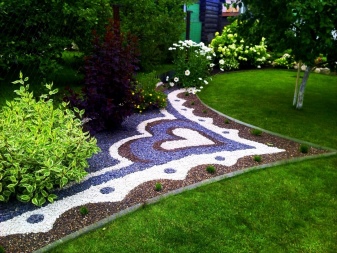
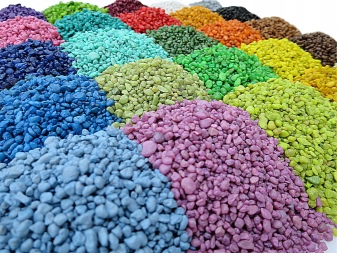
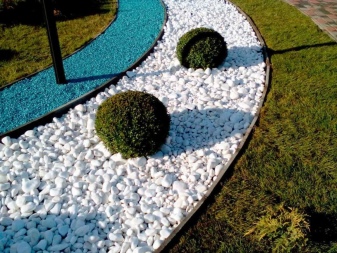
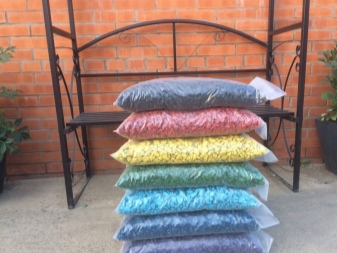
Peculiarities
Decorative crushed stone, both multi-colored and monochrome, is in great demand in various areas of construction and landscaping. Its main advantages are increasingly attracting the attention of designers, gardeners and dachas. Natural stone most often has a gray or red color. A great rarity, but that is why samples with green inclusions are no less interesting in terms of design. Pure white crushed stone, obtained as screenings during the quarrying of marble, is also highly valued, a simple gray mineral is not of particular aesthetic value, it is mainly used as a background.
But decorative crushed stone is often obtained not simply by sorting the source material. Only occasionally does natural raw material have fully suitable aesthetic characteristics. To improve them, calibration is carried out and a layer of polymer is applied to increase the accuracy of the color hold.
You need to understand that high quality paint is expensive. And therefore, the purchase of cheap colored rubble threatens to clog the site or serious health hazards.
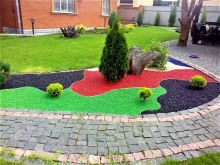
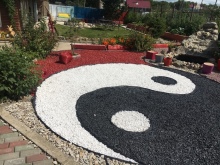
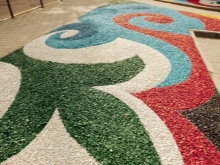
Self-production of such a product is also quite possible. But it will take a lot of time. As a result, it is more correct to order a large batch ready-made from the factory. To obtain crushed stone, one way or another, they use:
- crushed marble;
- gravel based on granite (these are the main options for budget and strength);
- shungite;
- quartzite;
- coil.
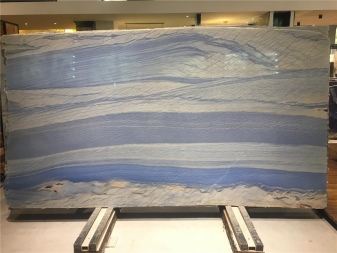
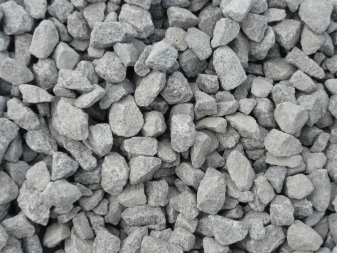

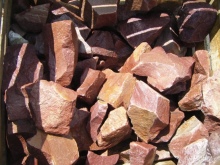
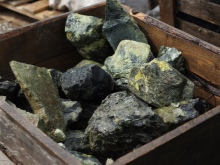
Finished coating:
- serves for years;
- perfectly resists temperature fluctuations;
- blocks the spread of weeds;
- improves soil micro-ventilation;
- helps to stabilize the structural composition of the earth;
- can be easily corrected, removed or heavily modified as needed.

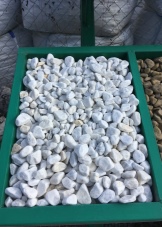
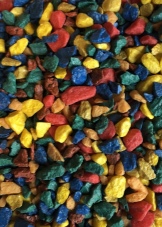
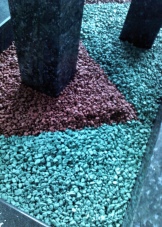
Where is it used?
Specially selected and prepared crushed stone is used:
- in landscape design;
- upon receipt of slabs for the sidewalk and adjoining area;
- as an integral part of decorative plaster;
- as an aquarium soil;
- as a decor for a mosaic floor;
- in the process of finishing various buildings from the inside and outside;
- for decorating monuments, tombstones and steles;
- to improve the quality of sites and yards (in the format of garden paths and monolithic dumps).
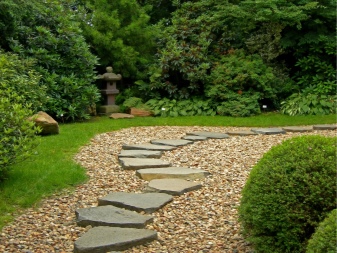
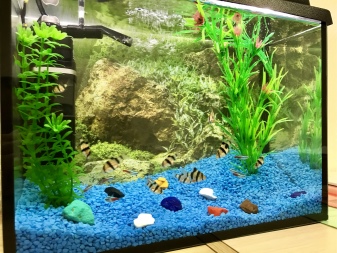
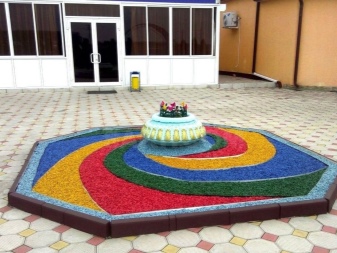
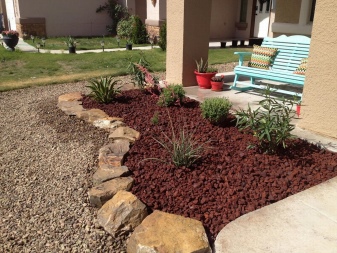
The stone is tamped tightly. Therefore, unlike a simple pebble, it is more comfortable and safer when walking. Importantly, removing dirt and debris from a monolithic surface is greatly simplified. You can easily sweep away dust, needles, leaf litter.
Park creators and gardeners appreciate the drainage properties of gravel, its ability to prevent the soil from drying out in the near-trunk circle.
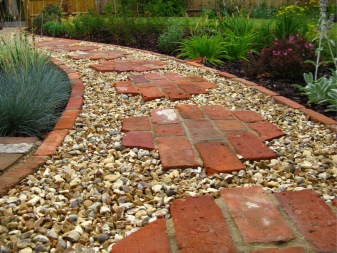
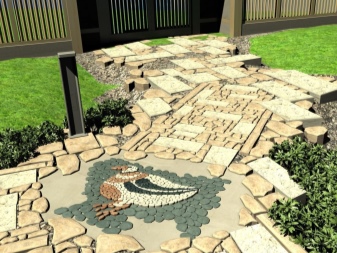
Decorative crushed stone is in demand in the organization:
- rosaries;
- simple flower beds;
- alpine slides;
- rock gardens.
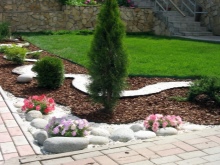
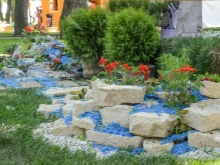
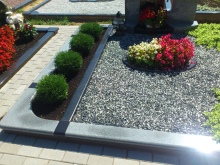
This backfill reliably prevents the land from drying out during long droughts. The formation of strong crusts on the surface is excluded. Therefore, the development of plants improves, they receive the necessary volume of air and water.When planting seeds of cultivated plants, contamination of the land with weed seeds and other self-planting is excluded.
It is worth noting that crushed stone is used to form a garden of stones, first of all, we are talking about the smallest fractions and screenings, which are combined with large stones and boulders.
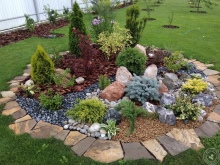
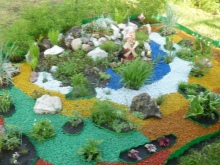

Production technology
Making decorative crushed stone with your own hands is not so difficult. But this requires carefully selected raw materials. Its preliminary:
- divided into fractions;
- washed;
- scrupulously cleaned of all litter.

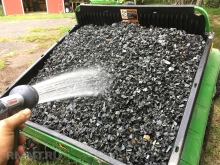
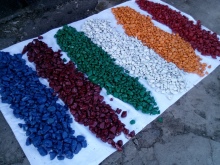
The original color scheme is not too fundamental. But it is still advisable to choose the most similar tone to the desired tone in order to simplify the work and use less paint. If a small amount of product is required to produce, the equipment required is not bought, but rented. For the manufacture of decorative crushed stone in the most minimal version you will need:
- concrete mixer;
- special fine-mesh grate for drying painted stones;
- reservoir for the drain of excess dye.


But sometimes you have to work with poorly sorted or completely unsorted material. To separate it into fractions, "screens" are used. It is best to purchase them ready-made, because it is economically unreasonable to make them from scratch. It is worth considering that decorative crushed stone is made from a variety of raw materials, even from solid household waste. However, natural limestone crushed stone cannot be used.
The point is that it will absorb a lot of paint. And even special processing methods do not allow obtaining visual gloss. Factory professionals choose polymer dyes. They are water-resistant and non-toxic.
The coloring reagent is diluted with water to a certain consistency and then mixed with gravel in the proportion: 1 part of the dye to 5 parts of gravel.
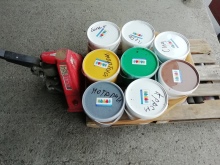
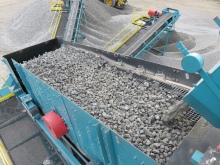
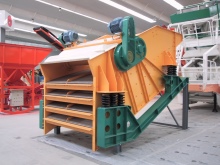
Stone chips are placed inside the concrete mixer. After pouring a suitable amount of colorant, the device is started up. Mixing with color takes about 60 minutes. Next, the material is placed on a grid, under which there is a reservoir for collecting unspent dye. Then it can be reused.
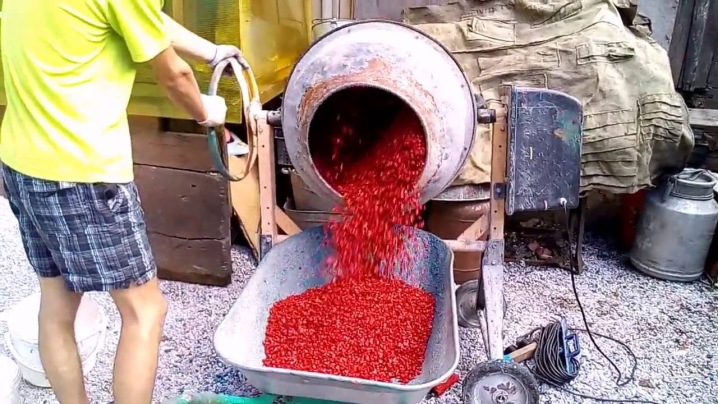
Full cycle production is organized as follows:
- send the stone to the crusher;
- achieve its crushing into fragments of approximately the same size;
- in the separator, crushed crushed stone is sieved fractionally;
- dry and clean stone raw materials;
- crushed stone is placed in a bin for painting (the same concrete mixer), which is filled with raw materials by 50%;
- wait 15-20 minutes;
- the painted stone is dried on a vibrating sieve;
- the resulting raw material is placed in a closed hopper;
- unpack it in bags for sale or for long-term storage.
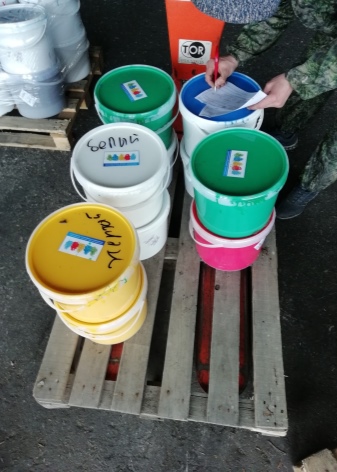
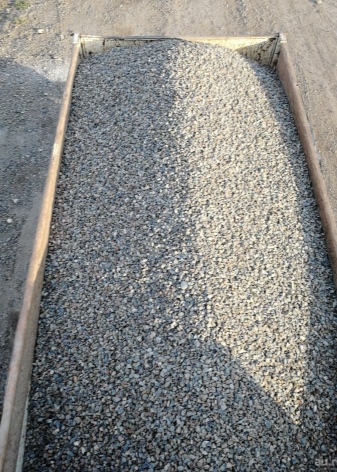
Very small amounts of rubble can be spray painted. The stones will have to be pre-processed. Such work can only be done with the necessary skill. Most often they choose for staining:
- acrylic;
- polyacrylic;
- enamels resistant to the atmosphere.
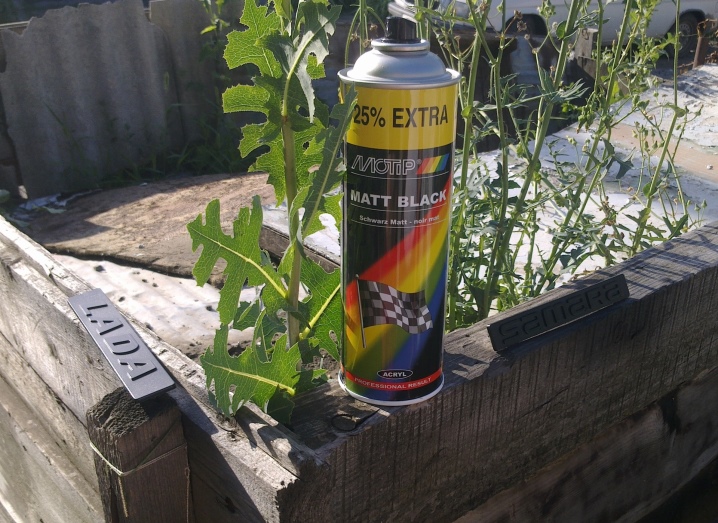
Dyes are evaluated for properties such as:
- insolation resistance;
- frost resistance;
- resistance to mechanical stress;
- environmental friendliness;
- water resistance;
- the degree of allergic activity.
In most cases, a fraction of about 10 mm is taken for coloring. The presence of fine sand and larger fragments adversely affects the technological process. Sifting stone at home can be done with steel mesh.
It is possible to speed up the drying of the painted material in the drying chamber. This is exactly what they do in serious industries.
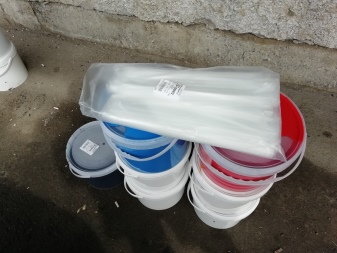
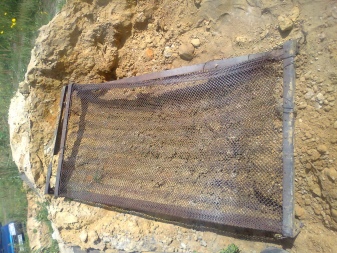
How to stack?
But even perfectly prepared decorative crushed stone should be laid strictly according to the standard. First of all, they prepare the place where it will be laid out. It is recommended to mark the perimeter boundaries with pegs and ropes. It will be correct to remove about 0.1 m of surface soil. Important: if the roots of the plants go deeper, you will have to choose them all, regardless of the complexity.
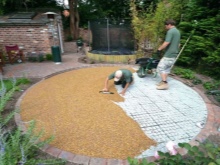
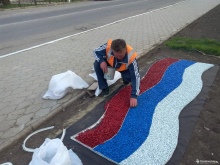
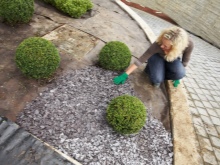
Next, sand is dumped. Its minimum thickness is 50 mm. This layer needs to be watered and leveled for good rainfall. Drawings are marked in advance, using approximately the same fences as for the composition as a whole, as well as stencils. The main laying is carried out according to the following scheme:
- perforated polyethylene flooring for water drainage;
- pour about 3 cm of sand;
- a pattern is formed on a stencil;
- cover the lawn or flower bed with 30 mm of gravel;
- colored material is poured onto the paths and playgrounds with a layer of 6 cm.
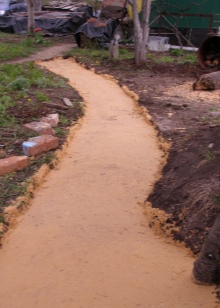
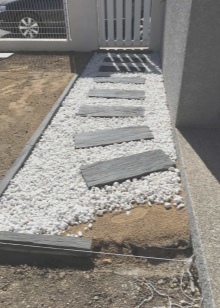
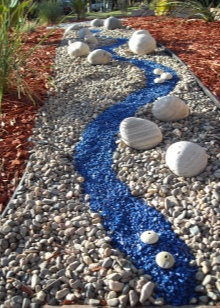
The styling technique may differ slightly. In the first case, they simply cut out the soil with a shovel of 100 mm. Then the following actions are performed:
- delimit the outer boundary with stones, curb tape (sometimes they are replaced with plastic or metal restraints);
- pour sand;
- level it and compact it;
- pour water over the layout to prevent further shrinkage;
- an agricultural insulating material is laid (most often a synthetic covering, optionally replaced by polyethylene);
- scatter 30 mm of sand;
- put colored stones;
- trim everything together with a rake for a better surface appearance.
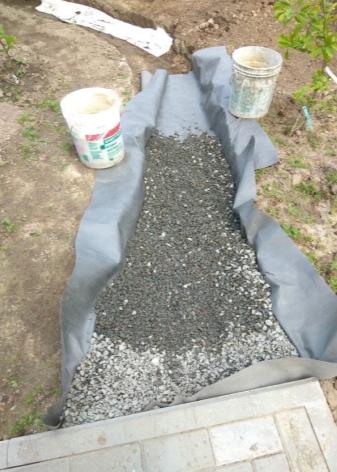
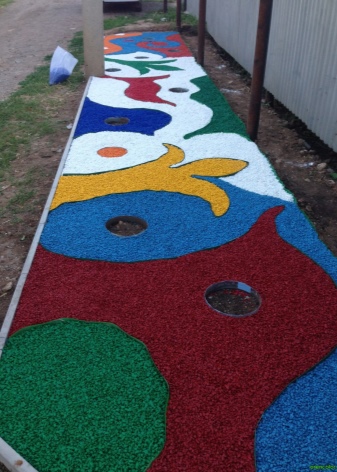
In the second option:
- prepare the soil, removing all uneven areas, weed roots with shovels and rakes;
- put dense material;
- pour 50 mm of concrete screed;
- provide drainage for water drainage;
- washed sand is poured over polyethylene or roofing material;
- put plastic or metal barriers around the perimeter;
- crushed stone is evenly poured;
- align it.
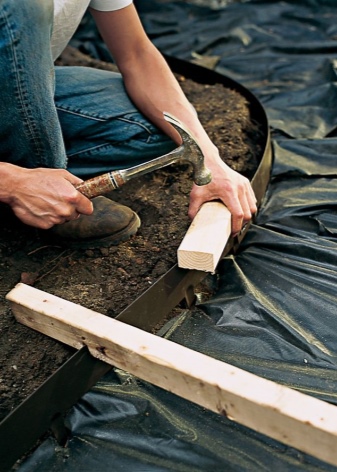
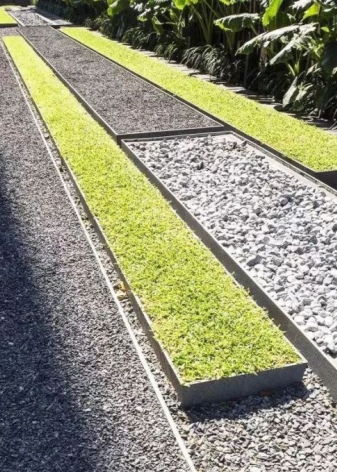
Normal laying of crushed stone implies the consumption of approximately 20 kg of material per 1 m2. This applies to a layer of approx. 20 mm. Crushed stone with a fraction of 2 cm is usually placed on the paths. This material allows the paths to dry quickly after rain. The streamlining of the fragments greatly simplifies the maintenance of cleanliness.


They act a little differently when it is required to prepare not a path or a platform, but a flower bed. You need to remove the ground 200-300 mm deep. Only under this condition it is possible to ensure that weed contamination of the plantings is avoided. Having cleared the area, they dig it up to the depth of the shovel bayonet. Immediately lay coarse sand or expanded clay (which is better suited in a particular case, you must decide on your own).
The soil is compacted with a roller. When this is done, a layer of geotextile is laid out. Special strips are placed in a continuous layer, making overlaps of 150 mm for greater reliability. In order for the fragments of the canvas to be connected firmly, they are tied with clamps. Holes every 3 m can be punched both before and after the gravel filling.
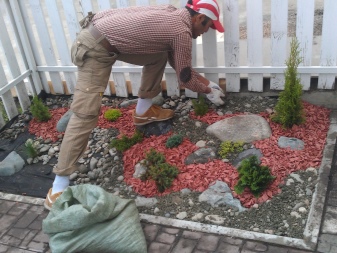

Examples in landscape design
There are many ways to use colored decorative rubble to decorate lots and land around your home.
- So, the photo below shows a combination of a wave-like layout of deep blue and ferrous rock.
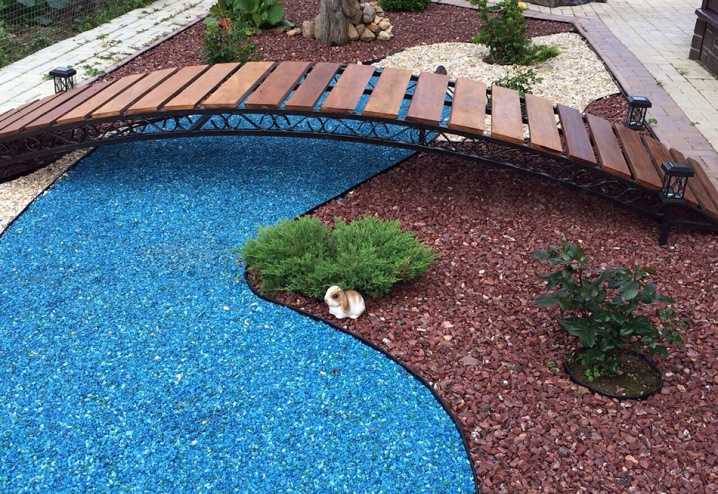
- But in the yard, you can also use a combination of light gray rubble as dominants with a stone of rich green, moderate dark red, bright yellow tones.
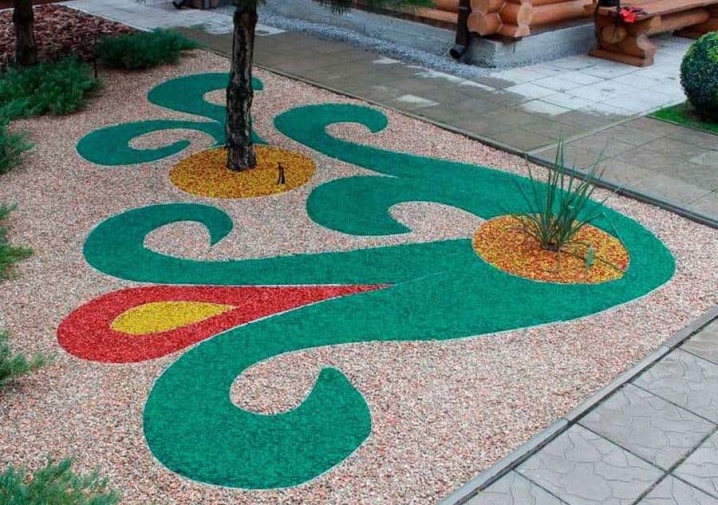
- This photo shows how colored rubble can be used to simulate the flow of a river.
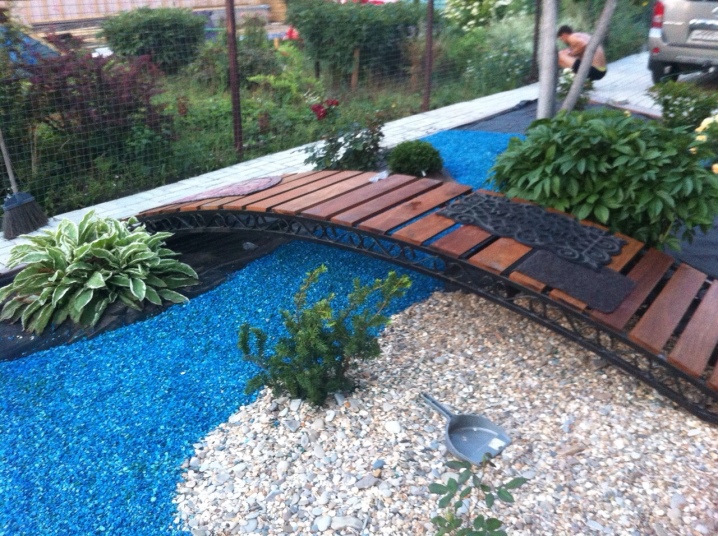
- Finally, you can combine areas of red, blue, and light gray pebbles.
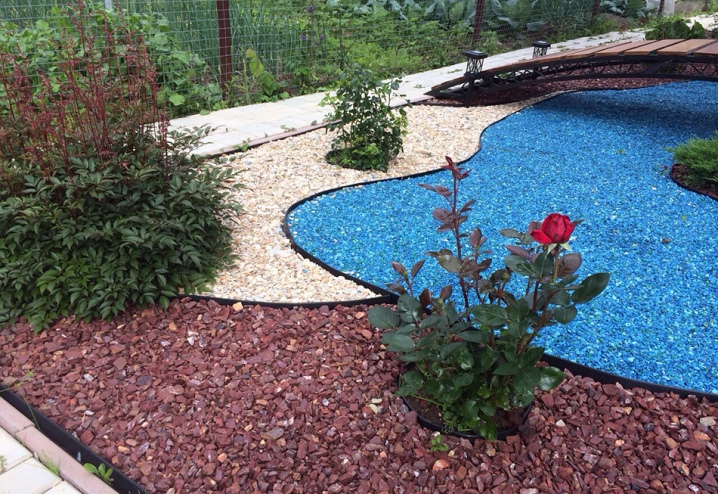
- But even on the listed options, the space of possibilities is not exhausted. This is how, for example, a harmonious combination of light gray and dim brick gravel looks like.
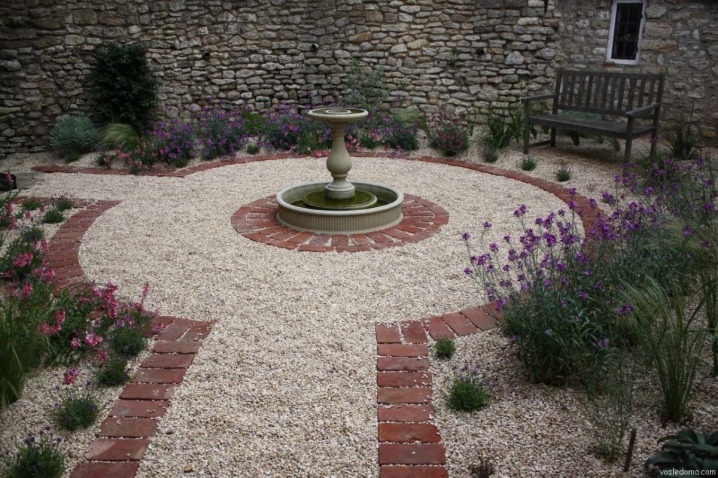
- By combining light and dark material in the form of a "screw", as if rotating, styling, you can get an equally attractive effect. A very small number of ornamental plants only emphasize the created perspective.
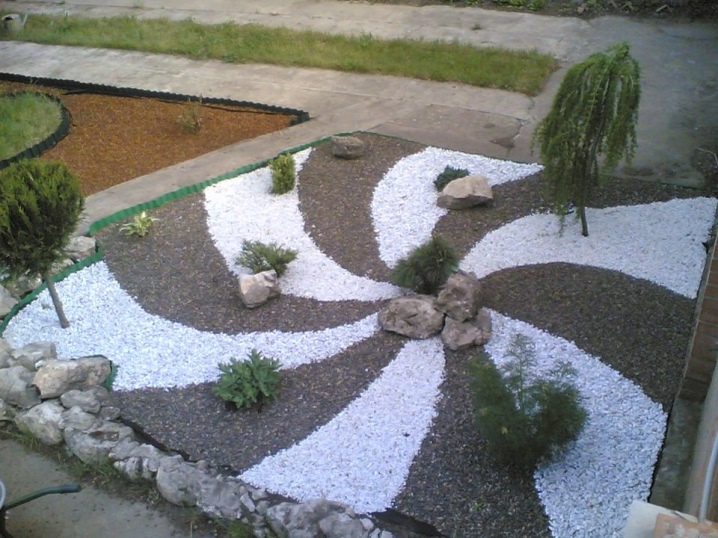
- But marble crushed stone of dark and light tones can be served a little differently in aesthetic terms; smoother and more straight, with fewer twists.
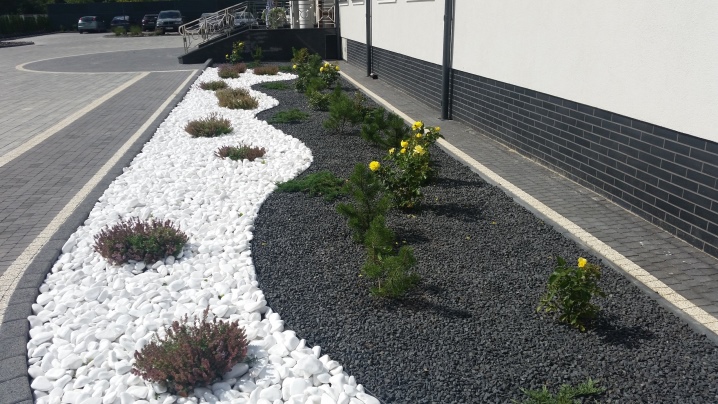













The comment was sent successfully.